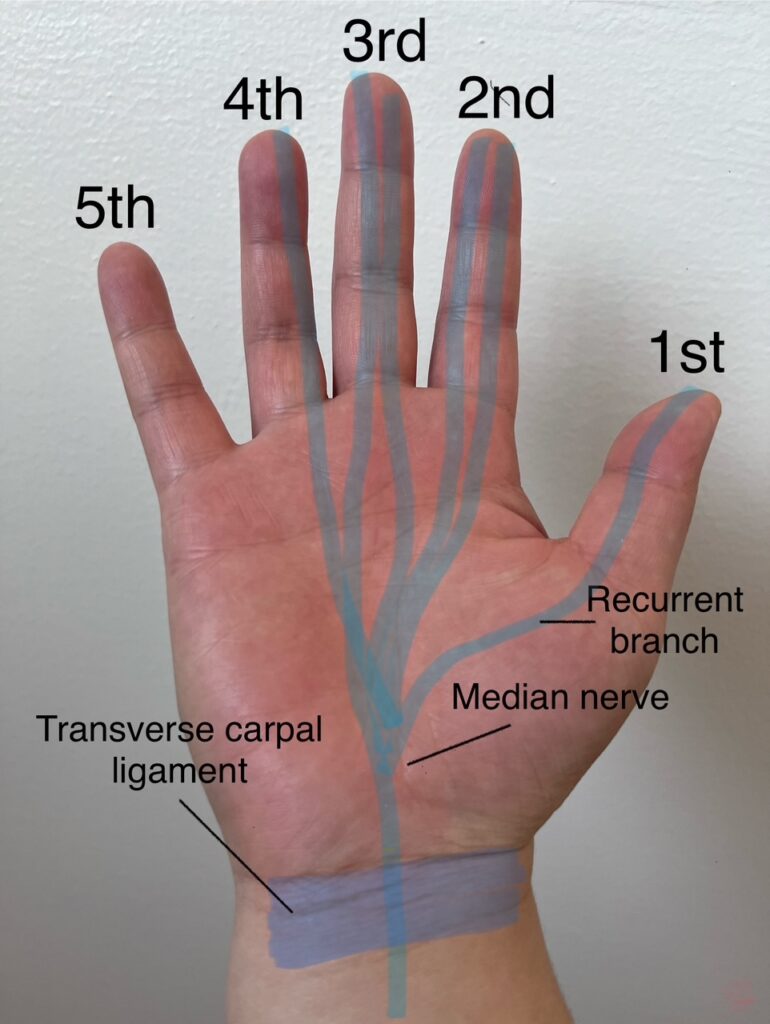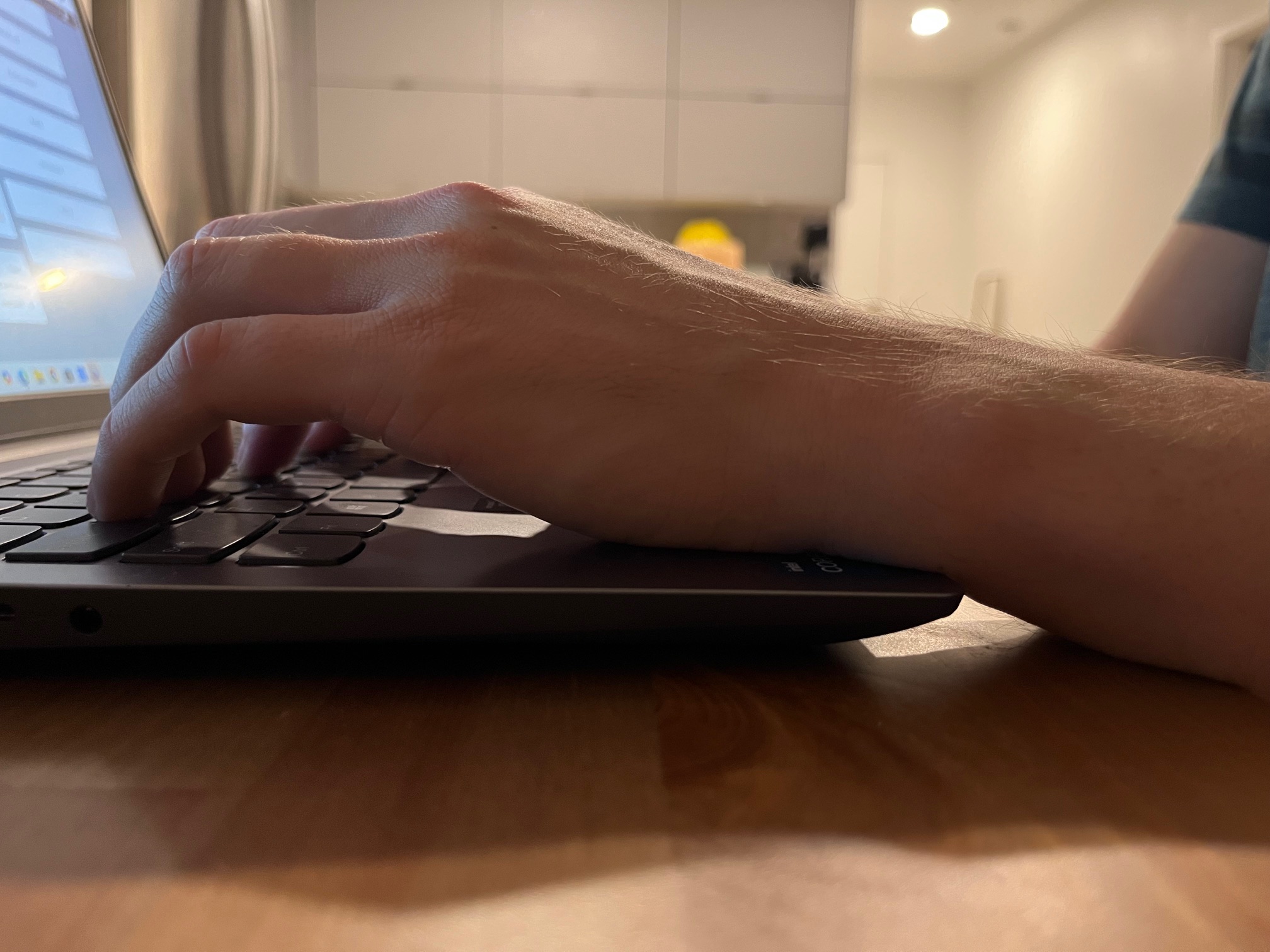If you have pain in your hand and wrist accompanied by some numbness and tingling in your fingers, you may be thinking: do I have carpal tunnel syndrome?
Possibly, but first, what even is carpal tunnel syndrome (CTS)?
What is carpal tunnel syndrome?
CTS is a condition where a specific nerve in the wrist is compressed, causing numbness, tingling, and sometimes pain in the hand and fingers.
CTS can be a potentially debilitating condition, affecting a person’s everyday life.
For a better understanding of carpal tunnel syndrome, let’s take a look at the anatomy of the wrist and hand as well as the general path of the nervous system in the arm.
Anatomy of the wrist and hand
The nerves of the upper extremity all originate from the neck and then join together at the shoulder area in a network of nerves called the brachial plexus. From there, they branch off into individual nerves heading down the rest of the arm. One of these nerves is the median nerve.
The median nerve is important when talking about CTS because it travels through the narrow passageway formed by bones and ligaments in the base of the palm, better known as the carpal tunnel.
Part of the reason CTS is such a common diagnosis is that the carpal tunnel is an already small space in normal human anatomy, which is then filled by the median nerve along with wrist flexor tendons.
With this being the case, any extra compression at the wrist or swelling of the finger flexors can cause this space to become even smaller, leading to easier median nerve irritation.
The median nerve has many branches, some of which travel to the first (thumb), second (index), third (middle), and half of the 4th (ring) digits.
The compression of the median nerve at the wrist in CTS can affect some or all of these branches, which is why you may feel numbness or tingling in these fingers.
The part of the median nerve that branches off to the thumb is called the recurrent branch, which innervates the muscles located at the base of the thumb (thenar eminence).
When the recurrent branch of the median nerve is compressed, it is unable to adequately work with the muscles, which is why you may notice atrophy at the thenar eminence.

Risk factors for CTS
Typing too much (8 hours a day non-stop, 5 times a week) or performing repetitive hand/wrist movements are some activities highly associated with carpal tunnel syndrome.
The way these activities are performed as well as their duration can potentially cause increased compression of the nerve as well as microinflammatory responses, resulting in swelling and pain, and consequently decreasing the carpal tunnel space.
Moreover, a lot of the time, unknowingly, how you rest your hand/wrist while typing or using the mouse can make you prone to compressing your median nerve.
Typically, you want your elbows resting on the arm rests at a 90-degree angle and your wrists in a neutral position.
Additionally, you want to address how your shoulders and head are positioned. You want to take note if you are constantly in the forward head and rounded shoulders posture, as this can affect the median nerve from where it originates in the neck and shoulders.
It is not just desk jobs that are associated with CTS. People who perform a lot of repetitive gripping motions with their hands can also have carpal tunnel syndrome symptoms.
When you are performing a lot of forceful gripping or repetitive hand movements, this can cause your finger flexor tendons to swell up in the already small carpal tunnel.
Another risk factor for CTS may be your genetics. People who have naturally smaller wrists may lead to a smaller carpal tunnel, resulting in increased chances of median nerve compression.
According to this article, females are more likely to develop CTS because anatomically, their wrists are smaller.
Signs and Symptoms of CTS
Numbness and tingling in the first three fingers and half of the fourth finger
Atrophy of the thenar muscles
Reduced grip strength
“Beefy hands” compared to the non-involved side
Increased symptoms at night
Tendency to shake your hands to try to relieve symptoms
It is important to note that you cannot officially say you have carpal tunnel syndrome just by having one or more of these common symptoms.
The only way you can officially rule in this diagnosis is if you have a nerve conduction test performed, which is something to speak to your doctor about.
That being said, there are special tests to help support your hypothesis of having carpal tunnel syndrome.
Special tests
The special tests below are used to help support your diagnosis of CTS, and they were all designed to stress your median nerve.
Tinel’s at median nerve: you will use your index and middle fingers to tap the carpal tunnel, and a (+) result is reproduction of numbness and tingling or patient’s said symptoms
Phalen’s: patient will press the backs of the hands together with forearms parallel to the ground. A (+) result is if the patient’s numbness/tingling or pain are reproduced.
Reverse Phalen’s: patient will perform opposite of phalen’s, so they instead of pressing the backs of the hands together, they press the palms of the hands together with forearms parallel to the ground. A (+) result is if the patient’s numbness/tingling or pain are reproduced.
ULNT median nerve bias: a physical therapist will take a person’s affected arm into a series of positions where it will tension the median nerve. If the person’s symptoms are reproduced, the physical therapist will then instruct the patient to move another body part to tension the nerve even more or slack the nerve. A (+) is if the patient feels worse with the increased tension or better with the nerve on slack.
Carpal compression test: a physical therapist will compress the patient’s carpal tunnel to decrease the carpal tunnel. A (+) result is if the patient’s numbness/tingling or pain are reproduced.
Treatment
- If you work a desk job, ask your job for an ergonomic evaluation
- Avoid any forceful gripping of objects/items in early stages of recovery
- According to the Journal of Orthopaedic & Sports Physical Therapy, and orthosis to assist with maintaining a neutral wrist should be used at night (and during the day if there are no significant changes when orthosis is worn only at night).
- Include tolerable strengthening of the wrist extensors and lumbricals and nerve gliding exercises
- Include postural exercises
Exercise videos for carpal tunnel syndrome
These exercises target median nerve gliding, wrist extensor strengthening and posture. Performing these exercises should not be too painful (should not exceed 5/10 pain), however, going into a little bit of the pain is fine and encouraged.
- Median nerve glide (finger abduction/adduction)
2. Median nerve glide (cervical spine + wrist)
3. Thoracic spine extension with foam roller
4. Finger extensions
